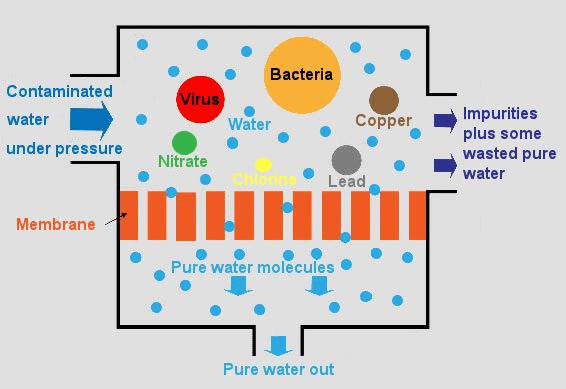What is reverse osmosis?
Reverse osmosis is a highly effective purification process. Its foundation is reversing the naturally occurring osmosis through a semi-permeable membrane to filter out impurities from water.
Osmosis naturally moves solvents or liquids across a membrane from the area of higher concentration to the side of lower concentration. In reverse osmosis, pressure is applied to make the liquid flow in the opposite direction, i.e., against the concentration gradient. It filters solute or dissolved particles from the liquid.
Ampac USA's Reverse osmosis water filters eliminate up to 99% of contaminants and impurities in water. They provide fresh water for a variety of commercial, industrial, and residential uses. As a leader in advanced Industrial and commercial Reverse Osmosis systems and residential water filters, we offer customized solutions based on your requirements and conditions. Our modular and multi-modular units deliver freshwater in the range of 30 to 500,000 gallons per day.
Reverse Osmosis Diagram
You can visualize the reverse osmosis process through the diagram below.

Reverse Osmosis Systems by Ampac USA
Ampac USA offers a comprehensive range of reverse osmosis systems tailored to various applications. These include residential, commercial, industrial, seawater desalination, and water store solutions. Each system is known for its durability, reliability, and easy-to-use design.
- Residential Reverse Osmosis Water Filters: Designed to provide high-quality drinking water for homes, these systems use advanced RO technology that gets rid of 99% of contaminants. We have options ranging from under-sink units to whole-house systems. They have multi-stage filtration processes and are compatible with various water sources, such as hard water, brackish water, well water, and seawater.
- Commercial Reverse Osmosis Systems: These RO systems are for businesses requiring purified water, including restaurants, coffee shops, breweries, and water stores. Their capacities range from 100 to 12,000 gallons per day (GPD). Our commercial RO systems are constructed with durable materials like powder-coated welded aluminum frames and stainless steel components.
- Industrial RO Systems: Ampac USA provides advanced industrial RO systems capable of producing between 6,000 and 100,000 GPD. They efficiently improve water quality by removing dissolved solids and contaminants.
- Seawater Desalination Systems: Our reverse osmosis seawater desalination systems convert seawater into potable water. They are ideal for marine applications, offshore installations, and areas with limited freshwater resources.
- Water Store Reverse Osmosis Systems: Water Store RO systems are aimed at entrepreneurs in the water retail industry. They are pre-plumbed and pre-wired for easy installation.
Industrial Reverse Osmosis Systems Brochure
Commercial Reverse Osmosis Systems Brochure
Portable Reverse Osmosis Seawater Desalination Watermakers
Contaminants Removed by our Reverse Osmosis Systems
Reverse Osmosis systems eliminate unwanted particles, molecules, and impurities, such as contaminants and sediments. They filter out chlorine, salt, and dirt from drinking water. In addition, our RO systems can also remove microorganisms.
The key contaminants removed by Ampac USA's reverse osmosis water purification systems include the following:
- Heavy metals like lead, mercury, copper, and arsenic
- Salts like sodium, chloride, sulfate, and nitrate
- Dissolved minerals like calcium, magnesium, and potassium
- Organic contaminants like VOCs, PFAS, pesticides, and herbicides
- Bacteria, viruses, and protozoa
Applications of Our Reverse Osmosis Systems
Tailored RO systems made by the engineers at Ampac USA are used in the following applications.
- Human Consumption
- Agriculture
- Humidification
- Ice-Making
- Rinse Waters
- Biomedical Applications
- Laboratory Applications
- Pharmaceutical Production
- Kidney Dialysis
- Water used in chemical processes
- Animal Feed
- Metal Plating Applications
- Wastewater Treatment
- Boiler Water
- Car Battery Water
- Semiconductor production
- Car Wash Water Reclamation
- Photography
- Cosmetics
- Hatcheries
- Restaurants
- Greenhouses
What Makes Reverse Osmosis Better Than Other Forms of Water Filtration?
Reverse osmosis solutions remove the most harmful contaminants that other forms of filtration cannot. They are also more cost-effective than bottled water and require little upkeep.
- High Contaminant Removal: RO systems remove up to 99% of contaminants, like mercury, lead, and chemicals.
- Improved Taste and Odor: RO systems strip away minerals and impurities.
- Wide Applicability: RO systems can purify water from seawater, rainwater, river water, and well water.
- Cost-Effectiveness: RO systems are more cost-effective than bottled water in the long term.
- Environmentally Friendly: RO is a physical process that doesn't require chemicals.
Water Filter vs. Reverse Osmosis
Water filters use a filter medium to trap contaminants, while reverse osmosis uses a semi-permeable membrane.
Water Filter
- Mechanism: Uses physical barriers like activated carbon
- Contaminants Removed: Chlorine, sediment, some bacteria, VOCs
- Maintenance: More affordable and simpler than RO
- Effectiveness: Good for particles, not dissolved solids
Reverse Osmosis System
- Mechanism: Uses semipermeable membrane + multiple filtration stages
- Contaminants Removed: 99% of heavy metals, salts, bacteria, chemicals
- Maintenance: Higher but manageable
- Effectiveness: Superior for comprehensive purification
Frequently Asked Questions
- Do reverse osmosis systems remove essential minerals from water?
Yes, but advanced systems add them back. - What is an RO water filtration system?
A system using membrane filtration to remove impurities. - How long does an RO system last?
Over 15 years with proper maintenance. - Do you need a water softener for reverse osmosis?
Yes, to protect the system from hardness damage. - Is it fine to drink reverse osmosis water?
Yes, it’s safe and beneficial long-term.

